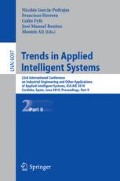Abstract
Data projections have been used extensively to reduce input space dimensionality. Such reduction is useful to get faster results, and sometimes can help to discard unnecessary or noisy input dimensions. Random Projections (RP) can be computed faster than other methods as for example Principal Component Analysis (PCA). This paper presents an experimental study over 62 UCI datasets of three types of RPs taking into account the size of the projected space and using linear SVMs as base classifiers. We also combined random projections with sparse matrix strategy used by Rotation Forests, which is a method based in projections too. Results shows that Random Projections use to be better than using PCA for SVMs ensembles.
Access this chapter
Tax calculation will be finalised at checkout
Purchases are for personal use only
Preview
Unable to display preview. Download preview PDF.
References
Achlioptas, D.: Database-friendly random projections: Johnson-Lindenstrauss with binary coins. J. Comput. Syst. Sci. 66(4), 671–687 (2003)
Fradkin, D., Madigan, D.: Experiments with random projections for machine learning. In: KDD 2003: Proceedings of the ninth ACM SIGKDD international conference on Knowledge discovery and data mining, pp. 517–522. ACM, New York (2003)
Vapnik, V.N.: The Nature of Statistical Learning Theory (Information Science and Statistics). Springer, Heidelberg (1999)
Rodríguez, J.J., Kuncheva, L.I., Alonso, C.J.: Rotation forest: A new classifier ensemble method. IEEE Transactions on Pattern Analysis and Machine Intelligence 28(10), 1619–1630 (2006)
Kuncheva, L.I., Rodríguez, J.J.: An experimental study on rotation forest ensembles. In: Haindl, M., Kittler, J., Roli, F. (eds.) MCS 2007. LNCS, vol. 4472, pp. 459–468. Springer, Heidelberg (2007)
Johnson, W., Lindenstrauss, J.: Extensions of Lipschitz maps into a Hilbert space. In: Conference in Modern Analysis and Probability. Yale University, New Haven and London (1982); Vol. 26 of Contemporary Mathematics, AMS, 189–206 (1984)
Ho, T.K.: The random subspace method for constructing decision forests. IEEE Transactions on Pattern Analysis and Machine Intelligence 20(8), 832–844 (1998)
Witten, I., Frank, E.: Data Mining: Practical Machine Learning Tools and Techniques, 2nd edn. Morgan Kaufmann, San Francisco (2005), http://www.cs.waikato.ac.nz/ml/weka
Fan, R.E., Chang, K.W., Hsieh, C.J., Wang, X.R., Lin, C.J.: Liblinear: A library for large linear classification. Journal of Machine Learning Research 9, 1871–1874 (2008)
Asuncion, A., Newman, D.: UCI machine learning repository (2007), http://www.ics.uci.edu/~mlearn/MLRepository.html
Breiman, L.: Bagging predictors. Machine Learning 24(2), 123–140 (1996)
Freund, Y., Schapire, R.E.: A decision-theoretic generalization of on-line learning and an application to boosting. Journal of Computer and System Sciences 55(1), 119–139 (1997)
Webb, G.I.: Multiboosting: A technique for combining boosting and wagging. Machine Learning 40(2) (2000)
Demšar, J.: Statistical comparisons of classifiers over multiple data sets. Journal of Machine Learning Research 7, 1–30 (2006)
Margineantu, D.D., Dietterich, T.G.: Pruning adaptive boosting. In: Proc. 14th International Conference on Machine Learning, pp. 211–218. Morgan Kaufmann, San Francisco (1997)
Maudes, J., Rodríguez, J.J., García-Osorio, C.: Disturbing neighbors diversity for decision forests. In: Okun, O., Valentini, G. (eds.) Workshop on Supervised and Unsupervised Ensemble Methods and their Applications, SUEMA 2008, pp. 67–71 (2008)
Author information
Authors and Affiliations
Editor information
Editors and Affiliations
Rights and permissions
Copyright information
© 2010 Springer-Verlag Berlin Heidelberg
About this paper
Cite this paper
Maudes, J., Rodríguez, J.J., García-Osorio, C., Pardo, C. (2010). Random Projections for SVM Ensembles. In: García-Pedrajas, N., Herrera, F., Fyfe, C., Benítez, J.M., Ali, M. (eds) Trends in Applied Intelligent Systems. IEA/AIE 2010. Lecture Notes in Computer Science(), vol 6097. Springer, Berlin, Heidelberg. https://doi.org/10.1007/978-3-642-13025-0_10
Download citation
DOI: https://doi.org/10.1007/978-3-642-13025-0_10
Publisher Name: Springer, Berlin, Heidelberg
Print ISBN: 978-3-642-13024-3
Online ISBN: 978-3-642-13025-0
eBook Packages: Computer ScienceComputer Science (R0)

